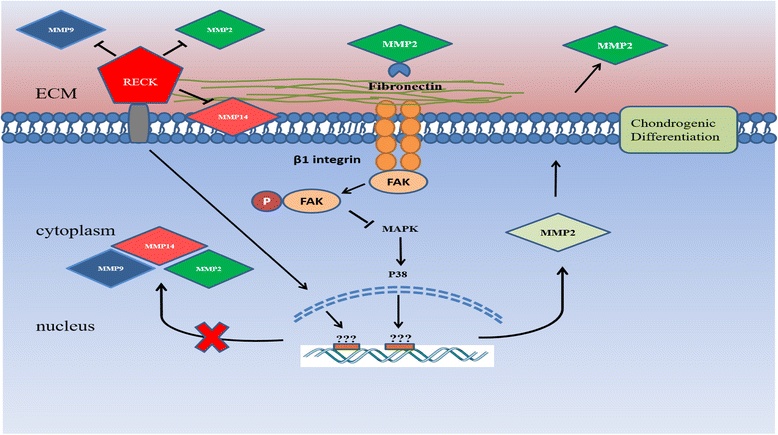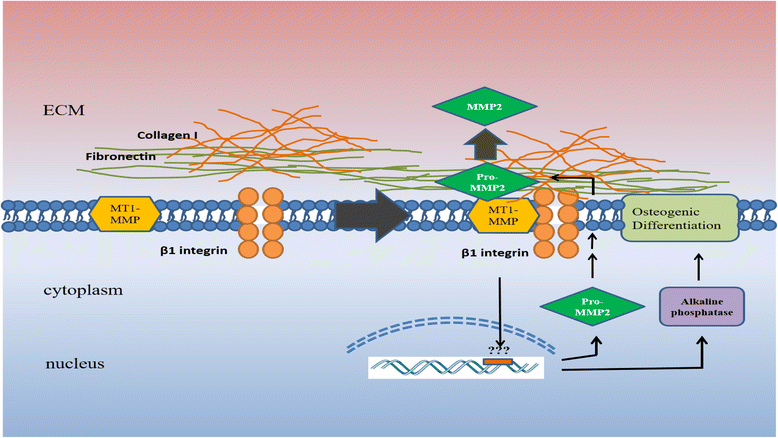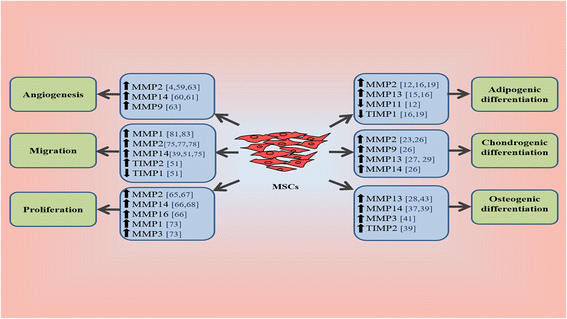Effects of matrix metalloproteinases on the fate of mesenchymal stem cells
- PMID: 27612636
- PMCID: PMC5016871
- DOI: 10.1186/s13287-016-0393-1
Effects of matrix metalloproteinases on the fate of mesenchymal stem cells
Abstract
Mesenchymal stem cells (MSCs) have great potential as a source of cells for cell-based therapy because of their ability for self-renewal and differentiation into functional cells. Moreover, matrix metalloproteinases (MMPs) have a critical role in the differentiation of MSCs into different lineages. MSCs also interact with exogenous MMPs at their surface, and regulate the pericellular localization of MMP activities. The fate of MSCs is regulated by specific MMPs associated with a key cell lineage. Recent reports suggest the integration of MMPs in the differentiation, angiogenesis, proliferation, and migration of MSCs. These interactions are not fully understood and warrant further investigation, especially for their application as therapeutic tools to treat different diseases. Therefore, overexpression of a single MMP or tissue-specific inhibitor of metalloproteinase in MSCs may promote transdifferentiation into a specific cell lineage, which can be used for the treatment of some diseases. In this review, we critically discuss the identification of various MMPs and the signaling pathways that affect the differentiation, migration, angiogenesis, and proliferation of MSCs.
Keywords: Adipogenic differentiation; Angiogenesis; Chondrogenic differentiation; Extracellular matrix; Matrix metalloproteinases; Mesenchymal stem cells; Migration; Osteogenic differentiation; Proliferation.
Figures



Similar articles
-
Human mesenchymal stem cells generate a distinct pericellular zone of MMP activities via binding of MMPs and secretion of high levels of TIMPs.Matrix Biol. 2014 Feb;34:132-43. doi: 10.1016/j.matbio.2013.10.003. Epub 2013 Oct 16. Matrix Biol. 2014. PMID: 24140982
-
Role and function of matrix metalloproteinases in the differentiation and biological characterization of mesenchymal stem cells.Stem Cells. 2006 Mar;24(3):475-81. doi: 10.1634/stemcells.2005-0333. Epub 2005 Sep 8. Stem Cells. 2006. PMID: 16150919 Review.
-
Extracellular matrix dynamics during mesenchymal stem cells differentiation.Dev Biol. 2018 May 15;437(2):63-74. doi: 10.1016/j.ydbio.2018.03.002. Epub 2018 Mar 12. Dev Biol. 2018. PMID: 29544769 Review.
-
Role of matrix metalloproteinases in migration and neurotrophic properties of nasal olfactory stem and ensheathing cells.Cell Transplant. 2013;22(6):993-1010. doi: 10.3727/096368912X657468. Epub 2012 Oct 3. Cell Transplant. 2013. PMID: 23043957
-
Key transcription factors in the differentiation of mesenchymal stem cells.Differentiation. 2016 Jul-Aug;92(1-2):41-51. doi: 10.1016/j.diff.2016.02.005. Epub 2016 Mar 21. Differentiation. 2016. PMID: 27012163 Free PMC article. Review.
Cited by
-
Osteogenic Efficacy of Human Trophoblasts-Derived Conditioned Medium on Mesenchymal Stem Cells.Int J Mol Sci. 2022 Sep 5;23(17):10196. doi: 10.3390/ijms231710196. Int J Mol Sci. 2022. PMID: 36077594 Free PMC article.
-
MMP9 mediates acute hyperglycemia-induced human cardiac stem cell death by upregulating apoptosis and pyroptosis in vitro.Cell Death Dis. 2020 Mar 13;11(3):186. doi: 10.1038/s41419-020-2367-6. Cell Death Dis. 2020. PMID: 32170070 Free PMC article.
-
Leucocyte and Platelet-rich Fibrin: a carrier of autologous multipotent cells for regenerative medicine.J Cell Mol Med. 2018 Mar;22(3):1840-1854. doi: 10.1111/jcmm.13468. Epub 2018 Jan 5. J Cell Mol Med. 2018. PMID: 29314633 Free PMC article.
-
Destroy to Rebuild: The Connection Between Bone Tissue Remodeling and Matrix Metalloproteinases.Front Physiol. 2020 Feb 5;11:47. doi: 10.3389/fphys.2020.00047. eCollection 2020. Front Physiol. 2020. PMID: 32116759 Free PMC article. Review.
-
Current understanding of the interplay between extracellular matrix remodelling and gut permeability in health and disease.Cell Death Discov. 2024 May 27;10(1):258. doi: 10.1038/s41420-024-02015-1. Cell Death Discov. 2024. PMID: 38802341 Free PMC article. Review.
References
Publication types
MeSH terms
Substances
Grants and funding
LinkOut - more resources
Full Text Sources
Other Literature Sources
Medical

